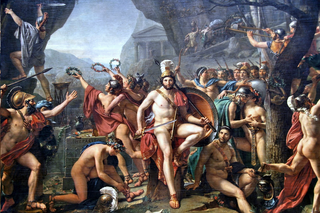Related Research Articles
In Greek legends, Procles was one of the Heracleidae, a great-great-great-grandson of Heracles, and a son of Aristodemus and Argia. His twin was Eurysthenes. Together they received the land of Lacedaemon after Cresphontes, Temenus and Aristodemus defeated Tisamenus, the last Achaean king of the Peloponnesus. Procles married Anaxandra, daughter of Thersander, King of Kleonoe, sister of his sister-in-law Lathria, and was the father of Soos and the grandfather of Eurypon, founder of the Eurypontid dynasty of the Kings of Sparta.
Eurysthenes was king of Sparta and one of the Heracleidae in Greek mythology. He was a son of Aristodemus and Argia, daughter of Autesion. He had a twin brother, Procles. Together they received the land of Lacedaemon after Cresphontes, Temenus and Aristodemus defeated Tisamenus, the last Achaean king of the Peloponnesus. Eurysthenes married Lathria, daughter of Thersander, King of Kleonae, sister of his sister-in-law Anaxandra, and was the father of his successor, Agis I, founder of the Agiad dynasty of the Kings of Sparta.
Leotychidas II was king of Sparta between 491–476 BC, alongside Cleomenes I and later Leonidas I and Pleistarchus. He led Spartan forces during the Persian Wars from 490 BC to 478 BC.
Agis I was a king of Sparta and eponym of the Agiad dynasty. He was possibly the first historical king of Sparta, reigning at the end of the tenth century BC, during the emergence of the Dorians in Laconia. He is said by most ancient authors to have conquered the region and enslaved the helots.

Agis IV, the elder son of Eudamidas II, was the 25th king of the Eurypontid dynasty of Sparta. Posterity has reckoned him an idealistic but impractical monarch.
Pleistarchus was the Agiad King of Sparta from 480 to 458 BC.
Cleomenes II was king of Sparta from 370 to 309 BC. He was the second son of Cleombrotus I, and grandfather of Areus I, who succeeded him. Although he reigned for more than 60 years, his life is completely unknown, apart from a victory at the Pythian Games in 336 BC. Several theories have been suggested by modern historians to explain such inactivity, but none has gained consensus.
Areus II was Agiad King of Sparta from 262 to 254 BC. He never reigned as he was still a child when he died. He was succeeded by his cousin Leonidas II, who had served as regent.

Leonidas II was the 28th Agiad King of Sparta from 254 to 242 BC and from 241 to 235 BC.
Anaxandridas II was an Agiad king of Sparta from c. 560 BC to 524 BC, father of Leonidas I and grandfather of Pleistarchus. Under the leadership of the ephor Chilon, in office during the middle of the 6th century, Sparta ended its streak of violent conquests, such as in Messenia, and adopted a pro-Achaea policy based on diplomacy. Anaxandridas was succeeded by Cleomenes I.
Archidamus I, also spelled ArchidamosI, was a king of Sparta, 12th of the Eurypontids. He reigned from c. 660 to c. 645.
Ariston was a king of Sparta, 14th of the Eurypontid kings, son of Agasicles, and contemporary of the Agiad king, Anaxandrides II. He reigned from approximately 560 BCE to shortly after 510 BCE. There are two main sources for him, Herodotus and Pausanias.
Eucleidas reigned Sparta from 227 BC to 222 BC. He was an Agiad, son of Leonidas II, in the place of the Eurypontid king.
Archidamus IV was Eurypontid king of Sparta from c. 300 BC to c. 275 BC. An obscure king, Archidamus is only known for his defeat against the Macedonian king Demetrius Poliorketes at Mantinea in 294, where he might have also died since nothing is heard of him afterwards. This defeat marks the beginning of a long eclipse for the Eurypontid kings, who are not mentioned again until the emergence of Agis IV 50 years later.
Eudamidas I was Spartan king between 331 and c. 300 BC. He succeeded his brother Agis III, who died at the battle of Megalopolis against Macedonia. Eudamidas' reign was therefore peaceful as Sparta recovered from this disaster. He even refused to join the other Greek states in the Lamian War in 323, and was later noted for his interest in philosophy—peculiar for a Spartan king.
Charilaus, also spelled Charilaos, Charillos, or Charillus, was a king of Sparta in the middle of the 8th century BC. He was probably the first historical king of the Eurypontid dynasty.
Theopompus was a Eurypontid king of Sparta. He is believed to have reigned during the late 8th and early 7th century BC.

The Agiad dynasty was one of the two royal families of the Ancient Greek city-state of Sparta. They ruled jointly along with the Eurypontid dynasty, possibly from the 8th century BC onwards, being the senior of the two houses. The hypothetical founder of the dynasty was Agis I, possibly the first king of Sparta at the end of the 10th century BC, who subsequently gave his name to the dynasty. The two lines, who maintained an enduring rivalry, were, according to tradition, respectively descended from the twins Eurysthenes and Procles, both descendants of Heracles. The most famous member of the Agiad dynasty was Leonidas I, known for his heroic death at the Battle of Thermopylae in 480 BC. The last Agiad king was Agesipolis III, deposed by the Eurypontid Lycurgus in 215 BC.
Soos was a fictional king of Sparta, created in the 4th century BC in order to harmonise the list of the two Spartan dynasties. Various deeds were also attached to his reign, dated by ancient authors to the 11th century BC.
References
- ↑ "Dictionary of Greek and Roman Biography". Archived from the original on 31 May 2013. Retrieved 1 May 2013.
